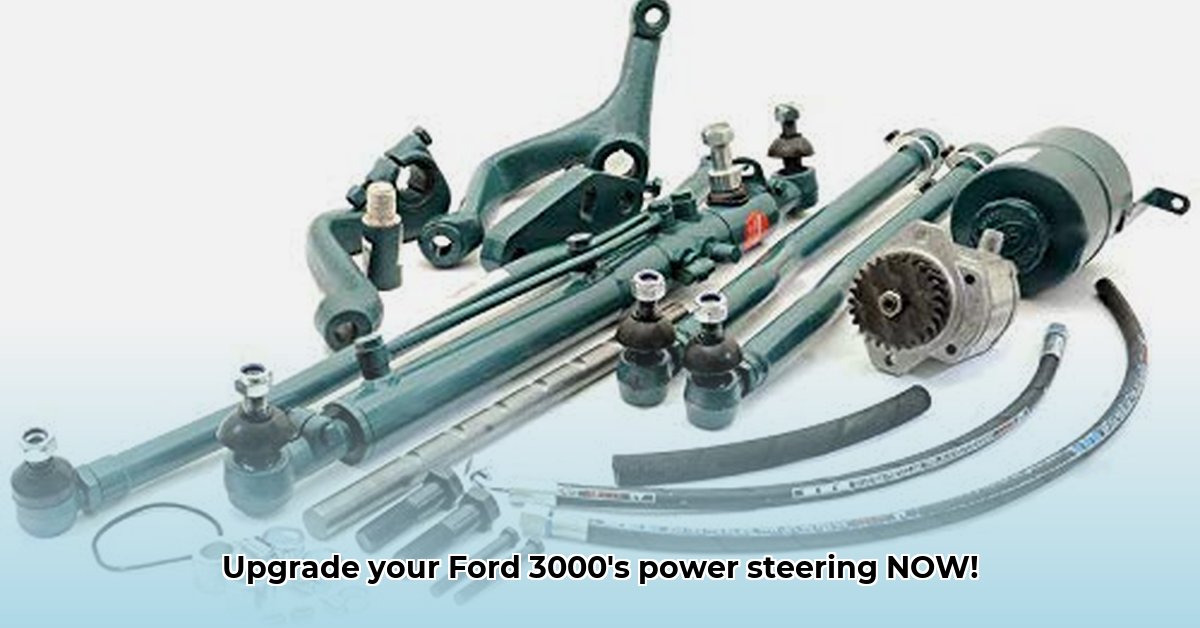
Keeping your Ford 3000 tractor running smoothly is crucial for efficient and sustainable farming. A well-maintained power steering system reduces operator fatigue, improves fuel efficiency, and extends the life of your equipment. This guide provides actionable steps for troubleshooting, maintenance, and minor repairs. For more Ford tractor resources, check out this helpful Ford Tractor Guide.
Understanding Your Ford 3000's Power Steering System
The Ford 3000 power steering system uses hydraulic pressure to assist in turning the wheels. This reduces the effort required, particularly when maneuvering heavy loads or working in challenging conditions. The system comprises several key components:
- Hydraulic Pump: This engine-driven pump generates the hydraulic pressure. (Think of it like your car's power steering pump.)
- Control Valve: This directs the flow of hydraulic fluid to the steering cylinder. (This acts as a switch, controlling fluid direction.)
- Steering Cylinder: This converts hydraulic pressure into mechanical force to assist in turning the wheels. (This is the muscle that actually turns the wheels.)
- Hoses and Lines: These transport hydraulic fluid throughout the system. (These are the pipes that carry the fluid around.)
- Hydraulic Fluid: The lifeblood of the system; ensures smooth operation and lubrication. (Always use the recommended fluid type.)
Troubleshooting Common Problems
Addressing problems early prevents larger, more costly repairs. Here are some common issues and their solutions:
Sluggish Steering: If steering feels heavy or unresponsive, first check the hydraulic fluid level. Low fluid is a common cause. If the level is correct, a faulty pump or control valve may be responsible. Consult a mechanic for diagnosis.
Steering Leaks: Any leaks should be addressed promptly. Identify the leak's source (hose, cylinder, pump). Minor hose leaks might be repairable with a clamp or replacement, while significant leaks usually require professional attention.
Stiff Steering: This could indicate low fluid, air in the system, or a problem with a component. Try bleeding air from the system (refer to your tractor's manual). If the problem persists, seek professional help.
Complete Power Steering Failure: If you have no power steering assistance, check the fluid level immediately. If low, refill, but call a mechanic if the problem persists—this is a serious issue. Don't operate the tractor without power steering.
Maintenance Procedures: Keeping Your System Healthy
Regular maintenance ensures peak performance and prevents costly breakdowns. A proactive approach saves time, money, and minimizes environmental impact through fuel efficiency.
| Task | Frequency | Importance |
|---|---|---|
| Fluid Level Check | Weekly or Bi-Weekly | Low fluid can damage the pump and lead to steering failure. |
| Hydraulic Fluid Change | Annually or as needed | Removes contaminants, extending component life and improving efficiency. |
| Belt Inspection | Monthly | A worn belt reduces power steering effectiveness. |
| Hose and Line Inspection | Monthly | Damaged hoses cause leaks. |
| Leak Checks | Weekly or Bi-Weekly | Early leak detection prevents catastrophic failure. |
Simple DIY Repairs (Proceed with Caution)
Some repairs are manageable with basic mechanical skills and appropriate tools. Always consult your tractor's service manual. Remember engine safety: never work on the power steering system with the engine running.
- Hose Replacement: Replacing a leaking hose is relatively straightforward, but ensure you use a hose of the correct type and size.
- Fluid Top-Off: Adding fluid is simple, but use only the manufacturer's recommended type.
For any repairs beyond these simple tasks, consult a qualified mechanic. Improper repairs can cause further damage, leading to expensive repairs and potential safety hazards.
Conclusion: Sustainable Practices, Sustainable Farming
Maintaining your Ford 3000's power steering isn't just about convenience; it's a crucial element of sustainable farming. Efficient power steering minimizes fuel consumption, reduces wear and tear on the tractor, and lowers your farm's environmental impact. Regular maintenance and timely repairs ensure a longer lifespan for your equipment and contribute to a more environmentally responsible agricultural operation. Remember that preventative maintenance is always the best strategy.